We interviewed Isabelle de Borchgrave just a few weeks before the opening of the exhibition ‘Miradas de Mujeres’ at the Royal Museums of Fine Arts in Brussels, Belgium.
The multidisciplinary Belgian artist, world famous for her impressive paper sculpture-dresses, reveals some details about this ambitious project with which she wants to bring to light a hitherto little-known side of Frida Kahlo.
The colossal 850 m2 installation invites the public to immerse themselves in the joyful universe of Frida Kahlo, allowing themselves to be inspired by the work of this contemporary Belgian artist whose creative oeuvre remains incomparable.
“Miradas de mujeres” recreates 40 of the Mexican artist’s dresses against the backdrop of the Casa Azul, the place of her birth and residence, inviting visitors to take an intimate journey to get to know Frida Kahlo as a woman.
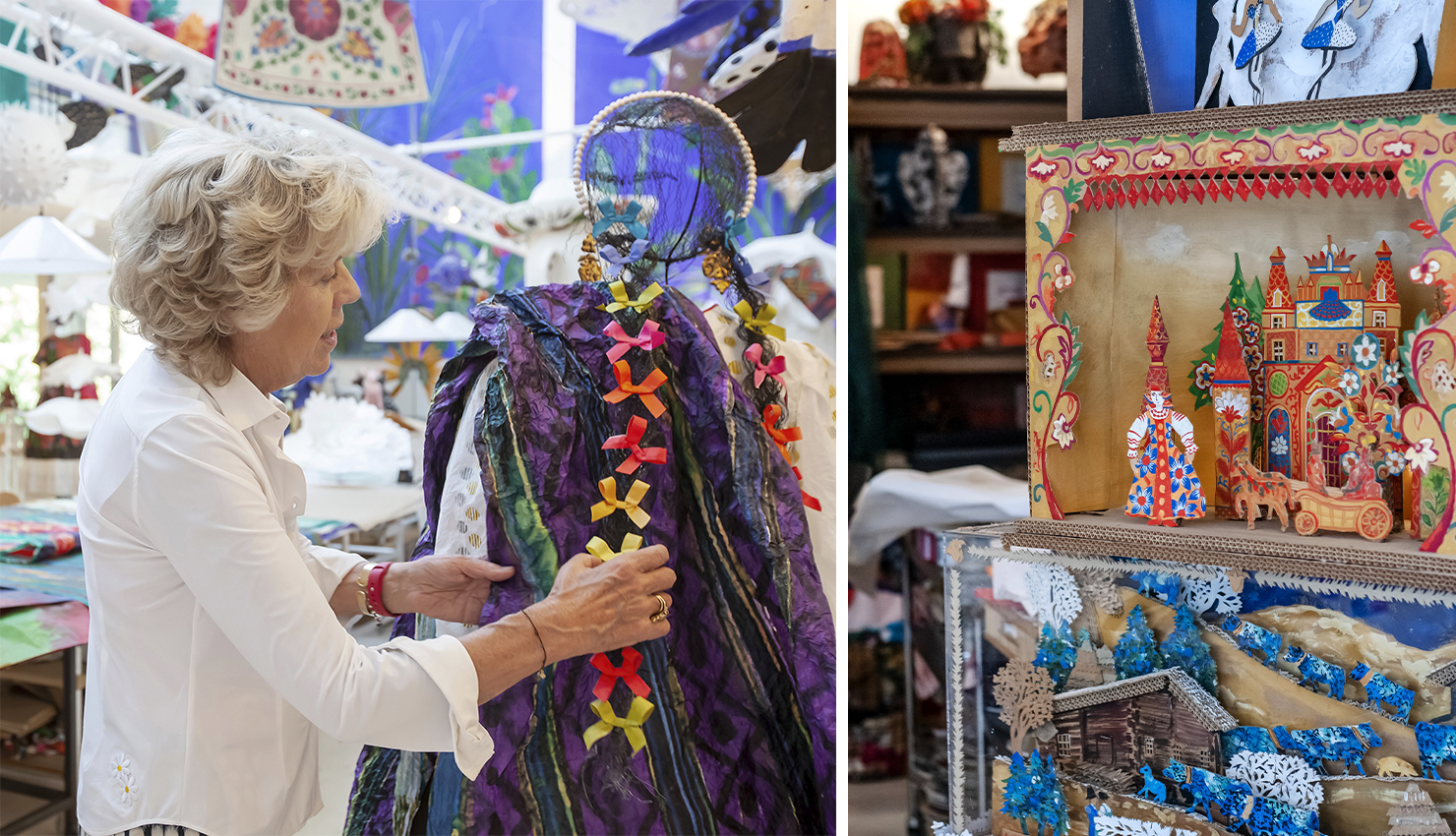
From left to right: Isabelle Borchgrave showing the representative braids worn by Frida. Through the vividness of color, she has managed to compose the joy and fantasy that reflected the Mexican artist’s work. Photo: Itsasne Casas
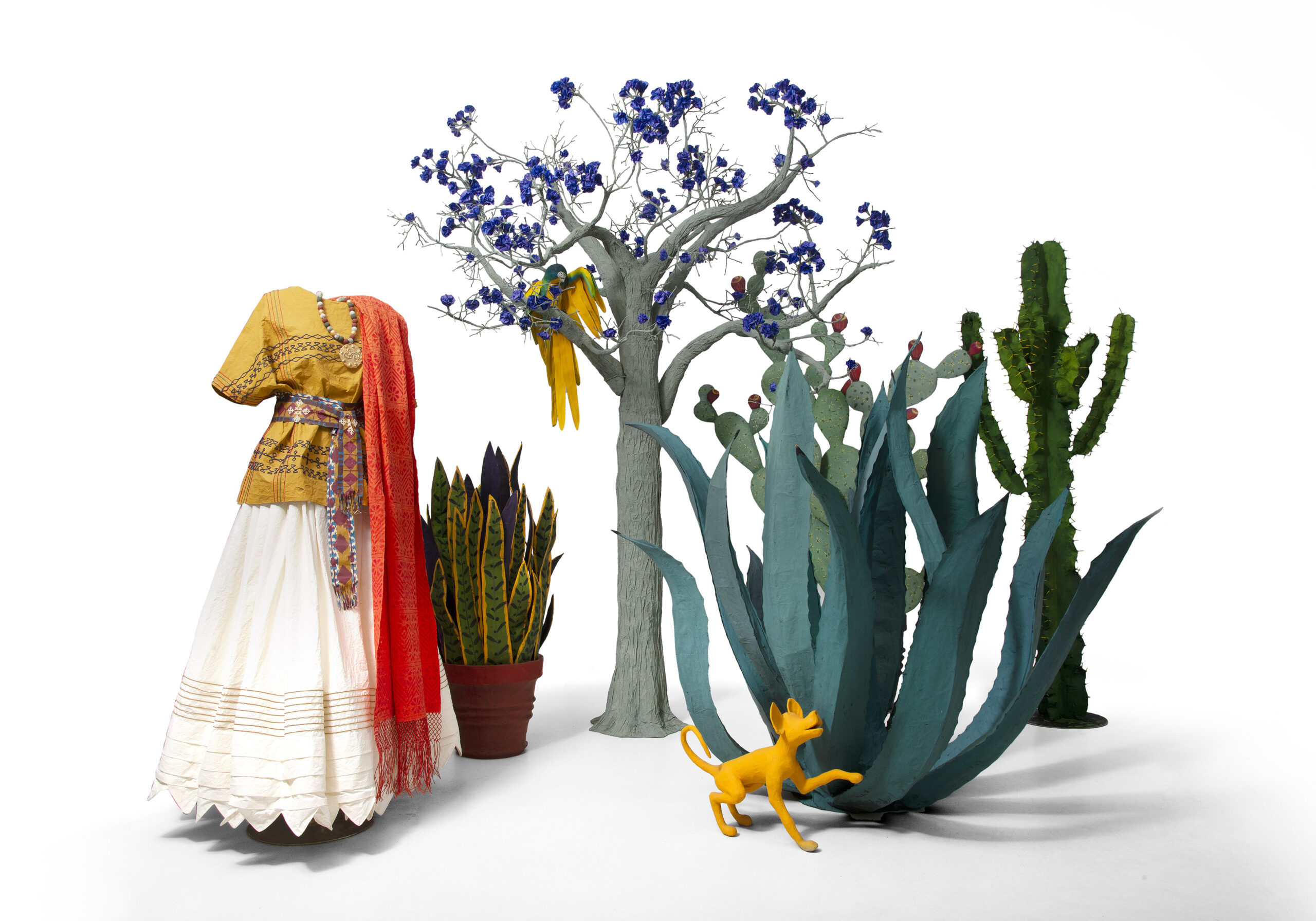
Miradas de mujeres allows visitors to step into Frida Kahlo’s day-to-day life, strolling through the tree and cactus-shrouded garden, the kitchen or the dressing room. Showing the connection between the two women, Borchgrave and Kahlo, and their love of paintings and canvases.
Horse: When did you start drawing and develop an interest in fashion?
Isabelle de Borchgrave: When I was little, I spent all day drawing and painting. I have always loved giving free rein to my imagination through drawing and painting.
My passion for fashion began around the age of 17 or 18, when I started designing and painting my own dresses for parties; I wore hand-painted “customised” dresses at a time when no one else was doing it….
Thanks to the success of my dresses I started to receive orders from friends and years later, after finishing my design studies, I dedicated myself for a while to making custom dresses.
H. How did the idea of making paper dresses come about?
I.B. It was 1994. On the occasion of a visit to an 18th century exhibition at the MET in New York, I became fascinated by that period and especially by the dresses of that time. The immense desire to own these dresses, which I would never be able to have, made me want to make them out of paper.
This is how Isabelle created the first collection of paper dresses in the history of fashion, entitled “Papiers à la Mode”. Composed of 350 dresses, it travelled to 40 countries and could be seen in cities such as London, San Francisco, Paris, Sao Paulo, Hong Kong and Toronto.

About 40 of Frida Kahlo’s personal dresses and outfits have been recreated by the Belgian artist. All of them made with paper and cardboard. Photo: Itsasne Casas
H. In “Miradas de Mujeres” you reflect your personal vision of F Kahlo’s world. Tell us what that vision is like.
I.B. Miradas de Mujeres is an intimate journey to discover the personality of Frida Kahlo. By delving into her universe and deepening my knowledge of Frida as a woman, I discovered a side of her that is little known to the general public. I realised that we had many things in common, such as a passion for fashion, a taste for colour, painting, nature, welcoming friends at home…
I realised that we had many things in common such as a passion for fashion, a taste for colour, painting, nature, receiving friends at home….
Frida was a strong, feminist, independent, self-taught and courageous woman who fought against convention, but she was also a person who knew how to enjoy life’s little pleasures.
People have always talked about her tragic life, her illness, her misfortunes, but not so much about her side as a flirtatious and super feminine woman who never left the house without dressing up and who enjoyed life despite adversity. This is the vision I intend to convey in the exhibition.
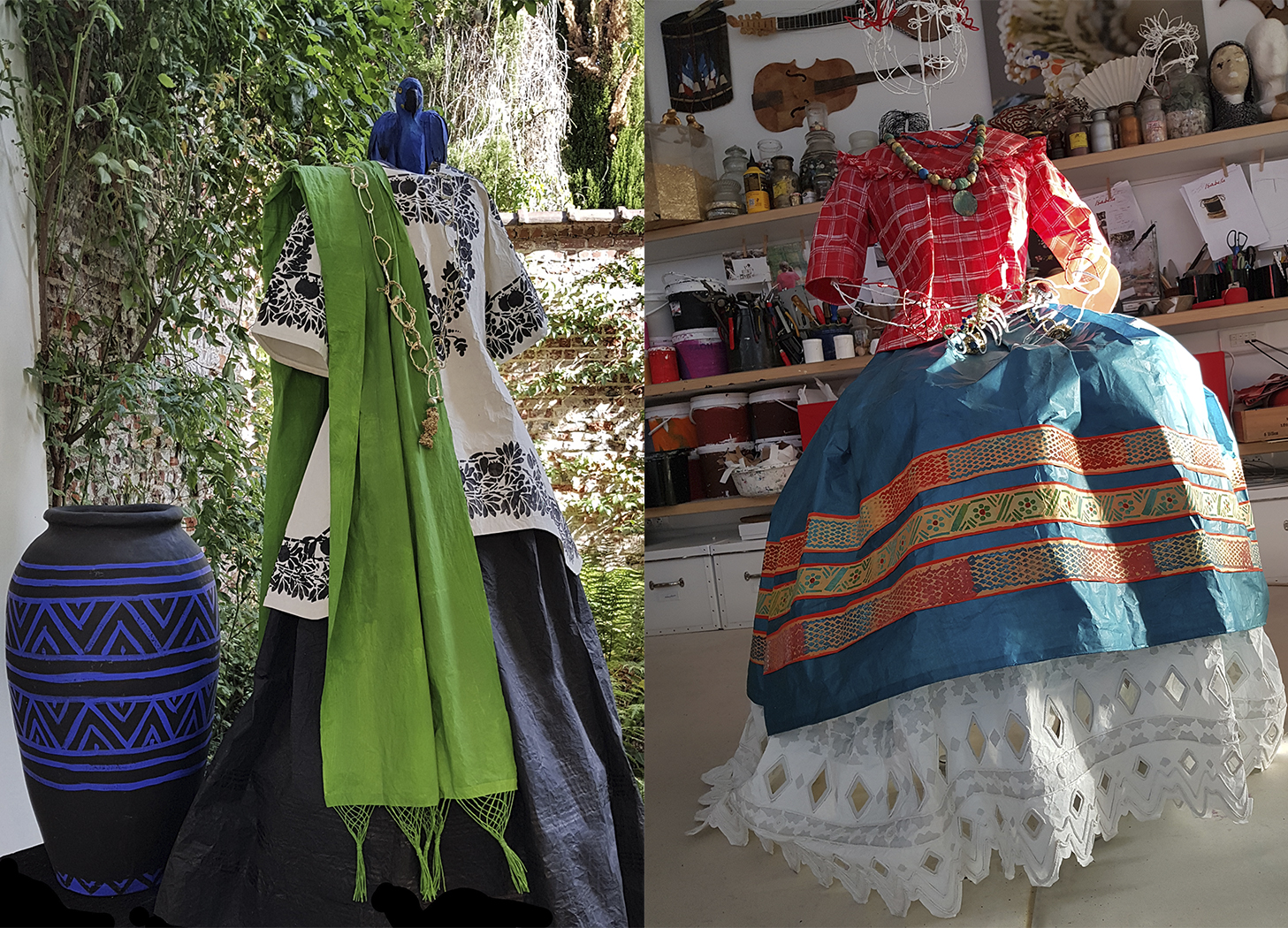
Isabelle recreates on paper the colorful dresses that Frida wore.
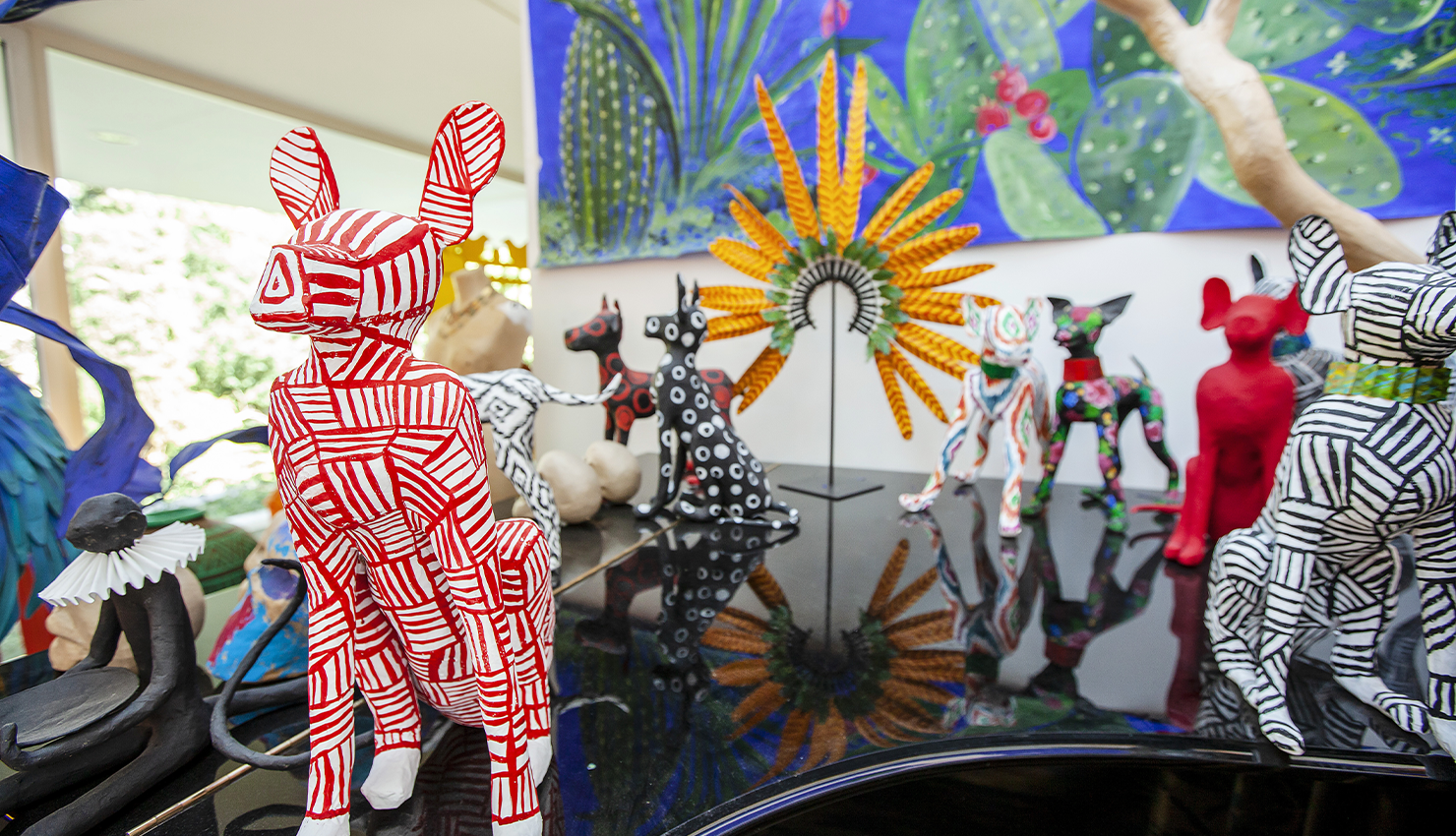
The figure of the Xolos dogs has been present in the paintings of the artist Frida Kahlo, as she enjoyed them in the Casa Azul. The companionship, loyalty and joy of the animals reinforced her mood in the most complicated moments. Photo: Itsasne Casas
You have been to Mexico twice, was it to prepare for the exhibition or did the idea for the exhibition come out of those trips?
The first time I went to Mexico on my own. In Mexico, each region has its own way of weaving and embroidering. I felt a strong attraction to their culture and I wanted to return there to soak up Frida’s spirit in order to make Frida’s dresses out of paper.
They invited me to dinner at the Casa Azul, showed me the artist’s dresses and other personal objects so that I could soak up her universe. And they made me feel at home. It was an extraordinary experience and the inspiration was so great that I not only had the desire to make Frida’s dresses out of paper, but to go further and recreate the Casa Azul.

From left to right: Isabelle Borchgrave has recreated from dresses, carpets, furniture, trees and many other elements recreating Kahlo’s universe. To elaborate all this, we have many photographs and works of the Mexican artist. Photo: Itsasne Casas
You have many interests in common with Frida, but what separates you from the Mexican artist?
Politics. Frida Kahlo was a politically committed person and I am not.
Did you have to go through a lot of red tape to carry out the project?
The Frida Kahlo Foundation has been a great support from the beginning so that I could carry out the project. Everything has been quite easy.
It has taken almost three years of work to recreate the iconic Casa Azul. Has it been complicated to recreate the universe of F Kahlo?
It has been a titanic job because everything, absolutely everything, has been painted by hand: the dresses, the carpets, the furniture, the trees and all the other elements that formed part of Frida’s universe.

Left Isabelle de Borchgrave’s Isabelle showing the hand-painted paper birds, vases, flowers and plants. Right, one of the workbooks used to recreate the colossal exhibition.
It took 4 km of paper and cardboard to make the exhibition. What kind of paper did you use?
I always use very cheap paper, the cheapest in the world, but at the same time it has to be solid, because it has to be able to be handled and be able to withstand paint.
Do you plan to take the exhibition to Mexico?
Yes, I would love to. At the moment it doesn’t seem possible because of organisational problems, but I hope that later on it can be shown there.
What other countries would you like the exhibition to travel to?
New York, South America, Spain, Canada.
The figure of the Xolos dogs has been present in the paintings of the artist Frida Kahlo, as she enjoyed them in the Casa Azul. The companionship, loyalty and joy of the animals strengthened her spirit in the most complicated moments. Photo: Itsasne Casas
Let’s talk about her career
Her first exhibition Papiers à la Mode, with Rêves de Papier: Isabelle de Borchgrave interprète Mariano Fortuny, immerses us in the Venetian universe of the 19th century, I Medici- une Renaissance en papier… takes us to the streets of Florence at the time of the Renaissance and Les Ballets Russes pays tribute to Serge Diaghilev.
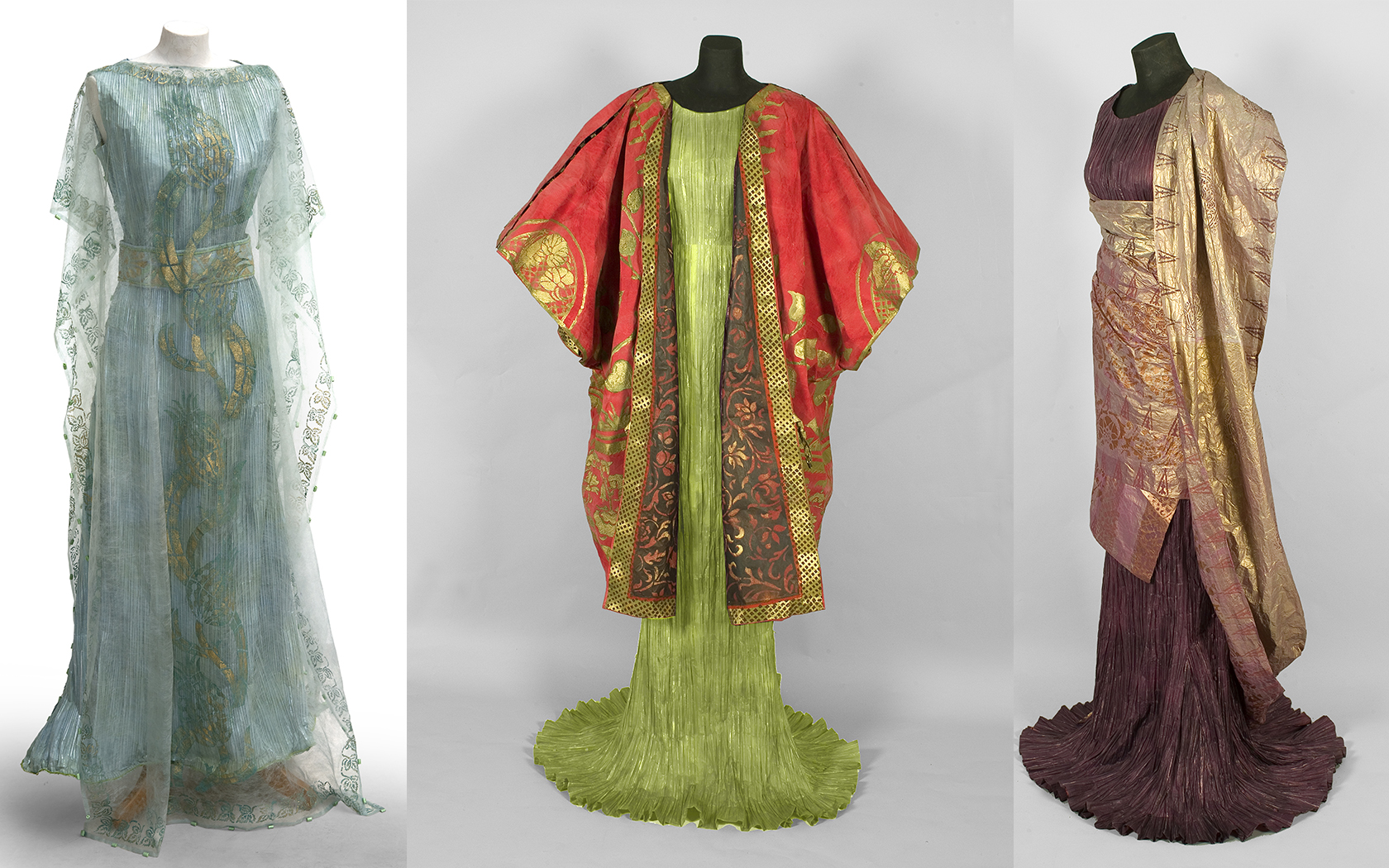
Isabel de Borchgrave dedicated a collection of paper dresses by designer Mariano Fortuny simulating fabrics such as silk, lace, fine pleated fabrics.
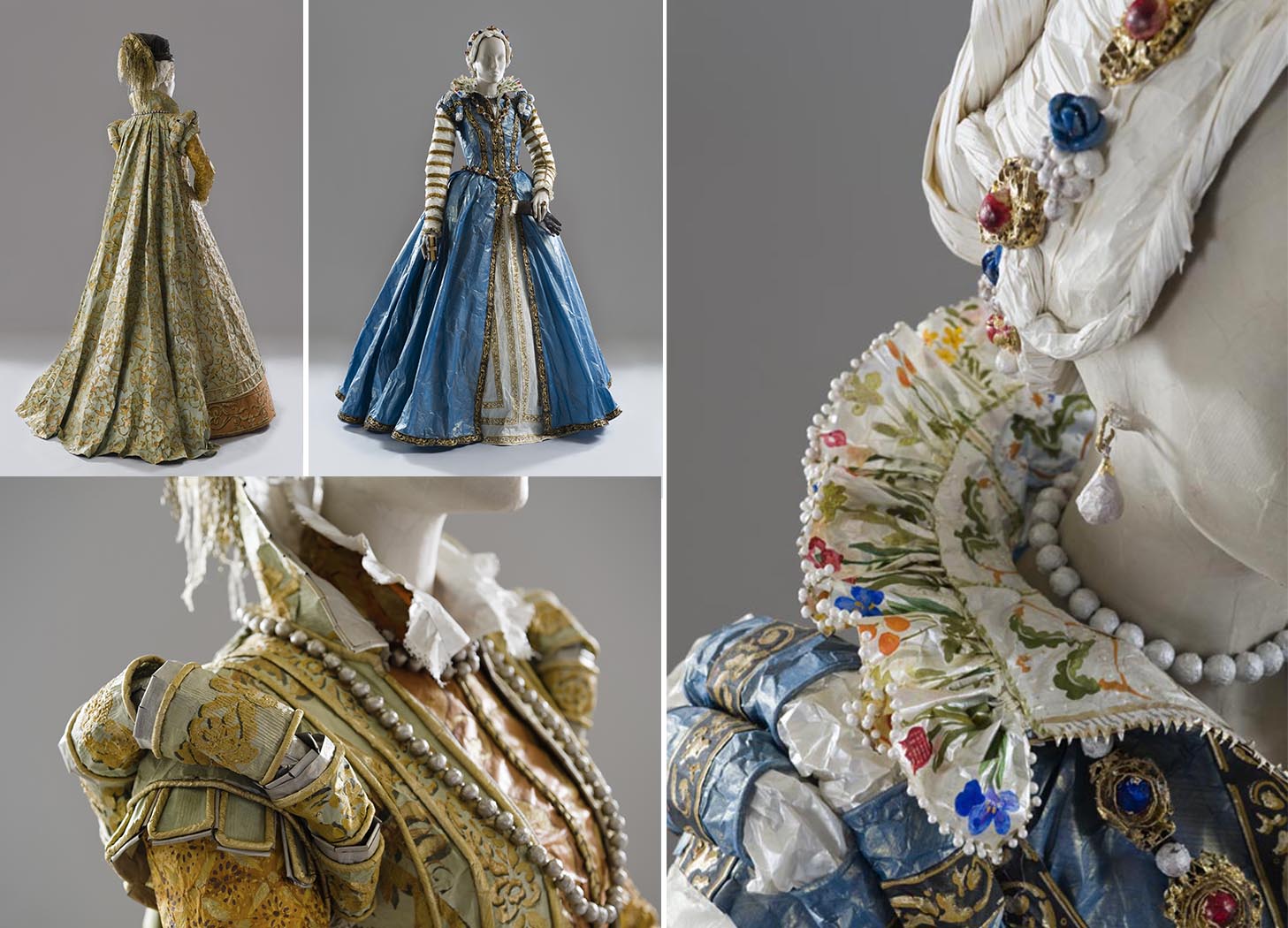
Exhibition “I Medici – A Renaissance in Paper” at the Cinquantenaire Museum, Brussels
You have recreated the history of fashion on paper, made paper dresses, painted pictures, designed decorative objects, furniture, and collaborated with prestigious houses such as Caspari, Gien, Target or Villeroy & Boch.
What do you still have to do, what dream do you still have to realise?
If I lived another 50 years I would love to recreate the Silk Road: the costumes, the caravans, the horses... I am also currently working on several private projects to tell other stories that I can’t talk about yet.
What is your most immediate project?
The decoration of the windows of the Hermès shop in Amsterdam this Christmas.
A few personal questions to get to know her better
- Something that has inspired you in your career: The 17th century. I have a predilection for old paintings, especially the great classical historical portraits. The jewellery, the lace and all the details of the portraits are extraordinary to me.
- You love to gather your friends around a good table, what food do you prepare for them when you receive them at home? Italian cuisine because it is light, quick and simple; it is a modern cuisine that everyone likes.
- The most complicated job she has done: Italian Renaissance dresses.
- The most rewarding: Miradas de Mujeres.
- A book that has marked you: I love biographies, especially biographies of artists: the life of painters like Matisse. I am currently reading the book Claude Monet- Georges Clémenceau, one story, two characters. I love learning about other people’s lives.
- A film that has moved you: The Painting of Gerhard Richter, directed by Corinna Belz.
- Something that moves you: Colour.
- A pending trip: Namibia.
- A trip you would repeat: Mexico.
- Is there a fetish dress or garment that has a special meaning for you? I love to buy shawls and scarves.
- Favourite colour: Red
- You collect works of art. What else do you collect? I collect scraps of fabrics from all eras that I bring back from my travels.
Musées Royaux des Beaux-Arts in Brussels, Belgium
14 October to 12 February 2023




